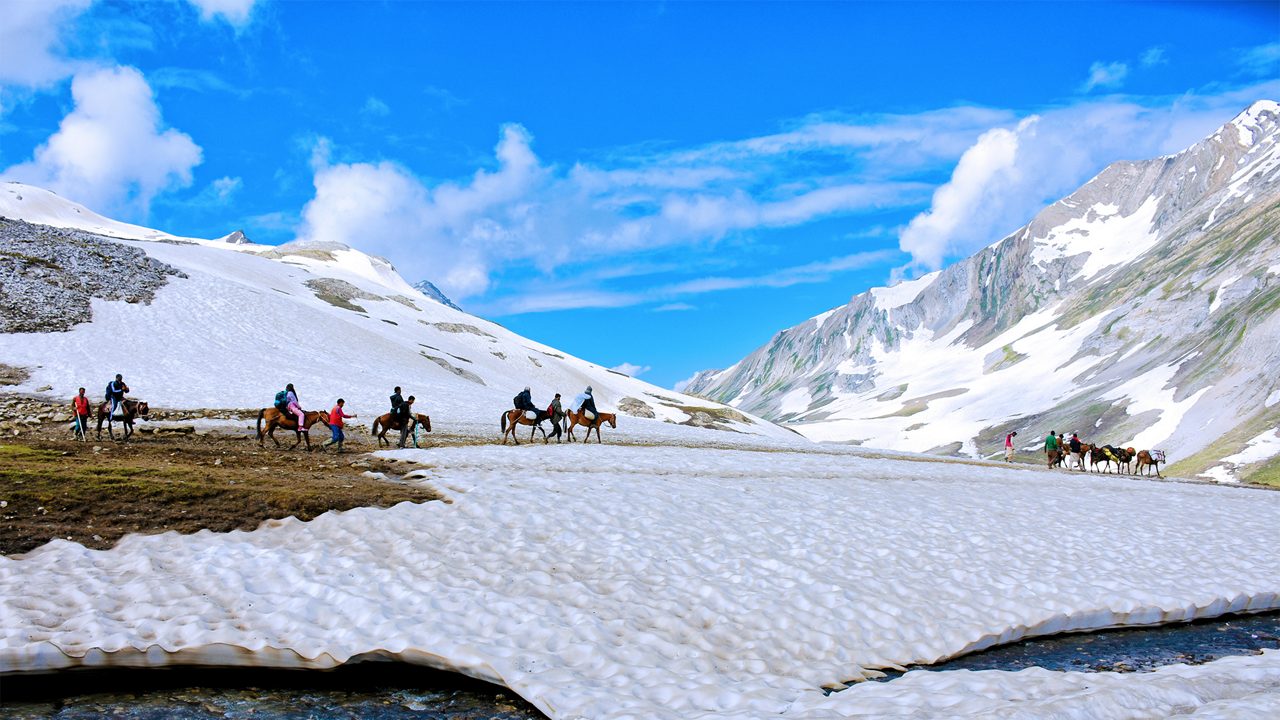
Kashmir: The Cultural Crossroads - 1
There are several dimensions of studies and research on Jammu and Kashmir. — Vinod Johri
Kashmir, Pakistan and China have always been in focus in domestic and international politics. However, we benchmark 1947 as starting point of our study and research on the partition of Bharat, illegal occupation of major part of Jammu and Kashmir by Pakistan and China or at best a decade earlier. Regular invasions from Pakistan in the façade of kabayalies, massive violence during partition, pouncing upon Hindu minorities by Islamic extremists as vultures during partition, the conspiracies and betrayals by Musim league, National Conference in partition of Bharat, role of United Nations in keeping the Kashmir issue alive and burning for more than two decades, have been reported in various newspapers during 1940 to 1960. Surprisingly and unfortunately, the historians and journalists of that period have not reported the British efforts, conspiracies and armed explorations to control Kashmir, Leh, Ladakh, Gilgit, Baltistan, NFWP since early eighteenth century for repulsing the Russians and containing & restraining Chinese from this region. I have gone through the major national newspapers of those times but find little about it. Hundreds of books have been written by the researchers, historians, senior army officers posted in the area, Bhartiya and foreign diplomats, academicians, explores on British-Russia-China rivalries for more than 150 years prior to independence, scarred by the partition and illegal occupation of Jammu and Kashmir by Pakistan and China. It looked that the agenda of invaders was hastily implemented by mutilation of Bharat by way of partition.
There are several dimensions of studies and research on Jammu and Kashmir. There are cultural dimensions too. In this article in two parts, an effort is made to share cultural affinity of Kashmir with the neighbouring countries on Buddhism. There is a detailed account on this subject in the book - The Crossroads – Kashmir - India’s Bridge to Xinjiang by Kulbhushan Warikoo – P-ISBN – 978-93-5702-569-0. This article is based on the contents of this book and honestly, all the material relates to this book which provides the detailed British-Russia-China rivalries for more than 150 yearsin Central Asia. I have not come across any such other research or books, which is an eye opener.
Kashmir, due to its close physical proximity and shared cultural affinity with Xinjiang, has been a hub for India’s socio-economic exchanges with Central Asia since ancient times. During the British rule the nature and extent of political and commercial interactions between Kashmir and Xinjiang were conditioned by the rivalry between the British and Russian empires for control over Central Asia. The British were quick to realise the strategic importance of Kashmir, and used their influence in the valley to restrain Russian designs on Central Asia. Kashmir and its frontier territories of Ladakh, Gilgit, Baltistan, Hunza and Nagar came to occupy pivotal position in the British strategy of checkmating Tsarist Russia and later Soviet Russia.
Due to its unique geographical position, Kashmir stood at the crossroads connecting mainland India with neighbouring regions of Gandhar, Afghanistan, Xinjiang, Central Asia and China. Notwithstanding the lofty barriers of Pamirs Karakoram and Hindu Kush ranges, there have existed since ancient times close cultural and socio-economic links between Kashmir including its frontier territories of Ladakh, Baltistan and Gilgit and adjoining regions of Xinjiang, Tibet and Central Asia.
During the Kushan period (second century BC to third century AD) when Central Asia and north-western India were integrated into single kingdom, various cities like Khotan, Kashgar, Balkh and Bamiyan had developed into important centres of Buddhism. This is amply borne out by archaeological finds at various sites in Kashmir and Xinjiang. The vast wealth of archaeological epigraphic and other remains found in Xinjiang in Khotan, Niya and other places, also testifies to diffusion of culture and Buddhism from Kashmir in Trans-Karakoram region.
Kashmir was a cradle from which Buddhism spread to different directions in Xinjiang, Central Asia, Tibet, China and beyond. Gilgit, Chilas, Chitral, Baltistan, Ladakh, Zanskar and another frontier areas of Kashmir have been important mileposts of the famed silk route. The preponderance of carvings and inscriptions of prehistoric and Buddhist periods in Gilgit-Baltistan region provides sufficient evidence of the prevalence of Buddhism in this region in pre-Islamic times. The sites at Shaital, Thor, Thaplan, Shingh Nala, Satpara, Kargah, Chilas etc., that still exists today, have high concentration of drawings of stupas, Buddhas, Bodhisattvas and Jatakas besides thousands of inscriptions written in Kharosthi, Brahmi, Sanskrit, Sogdhian and Tibetan scripts. Some 80 percent are in Brahmin script.
The famous Gilgit manuscripts containing the Lotus Sutra, written on birch bark, were first discovered by chance in a ruined stupa near Gilgit in 1931. These manuscripts contain Buddhist texts dating back to 5th and 6th centuries AD. The second lot of these manuscripts were discovered by Pandit Madhusudan Kaul during his excavation in Gilgit in 1938. A major part of the Gilgit manuscripts is in possession of the National Archives of India, which released the facsimile edition of its work on Lotus Sutra series on 3 May 2012, in association with Soka Gakkai International.
Professor Karl Jettmar and his Pak-German study group did pioneer work on rock carvings and inscriptions in this region. The diversity and density of rock carvings (about 5000 carvings and 5000 inscriptions) Gilgit-Baltistan turned the area into one of the most important petroglyph (Chattan par ukeri gayi) sites in the world. Unfortunately, over 30,000 carvings and descriptions are doomed to be inundated due to construction of Daimer-Bhasha Dam. According to Professor Harald Hauptmann of Heidelberg, who has worked on the heritage of this area for many years. 37,051 Carvings on 5928 boulders will be inundated. Hoffman added that some 3002 pass and a number of drawings were submerged under the dam (Yusuf Suhail, Threatened Rock Carvings of Pakistan). Obviously, it was through this region - which acted as crossroads of ancient routes and cultures, and attracted travellers, traders and pilgrims - that Buddhism was transmitted to Xinjiang and beyond.
Buddhism reached Xinjiang during Ashoka reign in third century BC. According to the ancient Khotanese beliefs, a son of Ashoka, named Kustana founded Khotan, in around 240 BC. His grandson, Vijay Sambhav is reported to have introduced Buddhism in Khotan. This dynasty is said to have ruled Khotan for several generations during which Buddhism was the religion of the state.
Some small colonies of Indians had come up in parts of southern Xinjiang, along with Silk route. Chinese scholars confirm that a Kashmiri monk, Virochana built a Buddhist shrine in Khotan in 80 BC, which became the first Buddhism Temple in Chinese history, and was worshipped mainly by Indian immigrants. They also affirm that ‘Buddhist art, as an arm of religion, was introduced by Yutian (Khotan) in Xinjiang from Kashmir, soon after founding of Yutian State. (Shen, Fuwei, Cultural Flow between China and outside world through history)
Buddhism spread from Khotan to Kashgar, Niya, Cherchen, Loulan, Aksu Kucha, Karashahar, Turfan and other parts of the China. The Kushans, particularly Kanishka who had extended his rule to Xinjiang, spread Buddhism far and wide in Xinjiang, Central Asia and China. Kanishka organised the fourth Buddhist council in Kashmir, in which around 500 Buddhist scholars were said to have participated. The proceedings of their debates were engraved on copper plates, put in the box and buried somewhere in Kashmir. Archaeologists are yet to locate this treasure trove buried somewhere in Kashmir valley. A Chinese Scholar Professor Liu Shiu Lin, noted the legacy of Kashmir’s cultural relations with China. He stated -
People of China knew about Kashmir since ancient times. China had a tradition of history writing cultural relations since ancient times. Has had a tradition of history writing since ancient times. Same tradition existed in Kashmir in the Indian subcontinent. Historiographical tradition of Kashmir is very ancient. The tradition of friendly and cultural relations between China and Kashmir is over 2000 years old. These ties flourished during the Buddhist period. Chinese monks would come to Kashmir to learn Buddhist philosophy and literature. They have left a valuable record about Kashmir. Chinese have transferred many such works (Mir. G.M. China and Kashmir, Ancient Political and Cultural Relations, Mirpur, 2002, Page-45).
(In the second part of this article, the detailed discussion will be made about Kashmiri Buddhist scholars in Xinjiang, China and Chinese scholars in Kashmir.)
Vinod Johri, Retd. Additional Commissioner of Income Tax, Delhi


